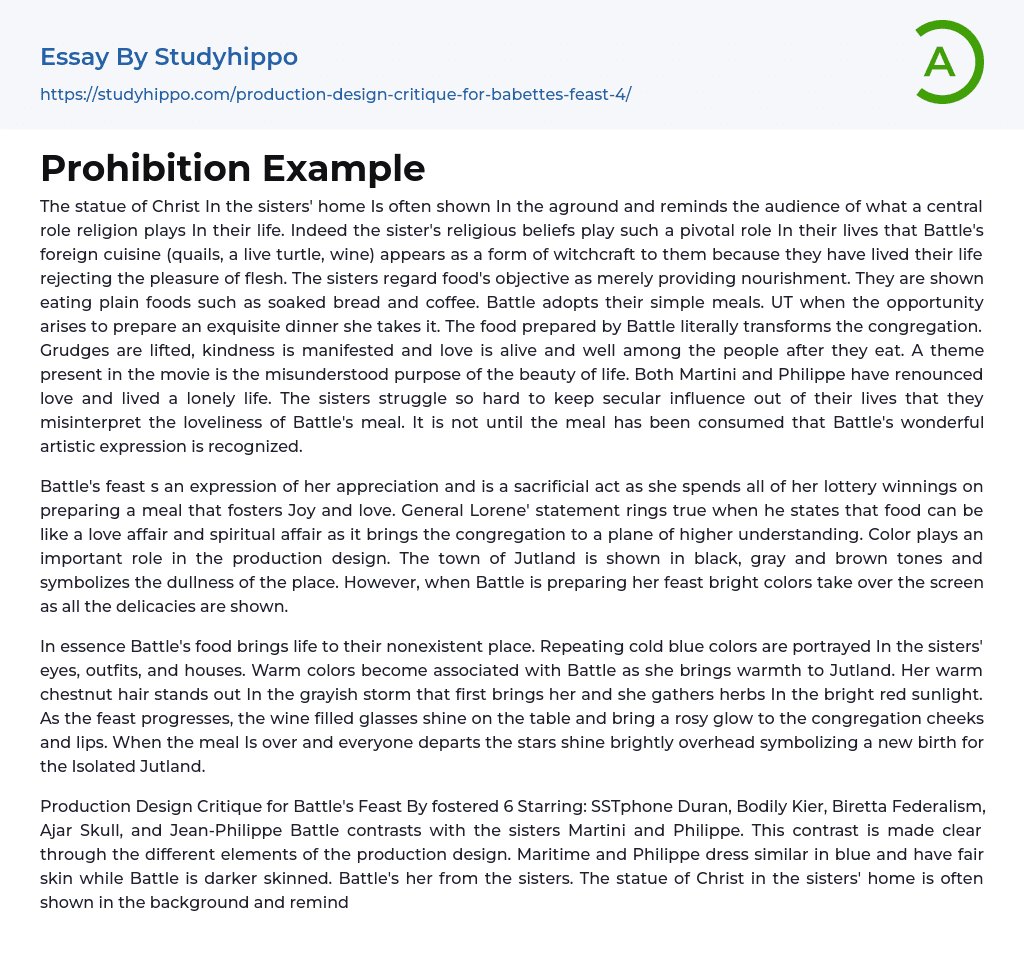The statue of Christ in the sisters' home is often displayed prominently, serving as a constant reminder of the significant role that religion plays in their lives. The sisters' strong religious beliefs have such a profound impact on them that they view Battle's foreign cuisine, which includes quails, a live turtle, and wine, as an act of sorcery. This is because they have chosen to reject the pleasures of indulging in earthly desires. Their perception of food is solely focused on its function to provide nourishment. Consequently, they typically consume plain meals consisting of soaked bread and coffee. However, when presented with the opportunity to create an exquisite dinner, Battle seizes it. The food she prepares has a transformative effect on the congregation. Grudges are let go, acts of kindness become evident, and love thrive
...s among the people after partaking in the meal. An underlying theme in the movie revolves around the misconstrued purpose of the beauty of life. Both Martini and Philippe have renounced love and lived lives filled with loneliness. The sisters strive to keep secular influences at bay so fiercely that they fail to recognize the beauty and artistry found in Battle's culinary creations until they experience it first-hand by consuming the meal. Battle's feast is her way of expressing gratitude and making a sacrificial gesture. She devotes all of her lottery winnings to preparing a meal that fosters joy and love among those who partake in it.The statement of General Lorene, that food can be both a love affair and a spiritual affair, resonates true as it elevates the understanding of the congregation. The use of color in the production design
is significant, with the town of Jutland portrayed in black, gray, and brown tones that symbolize its dullness. However, when Battle prepares her feast, vibrant colors take over the screen, showcasing the delicacies. Battle's food breathes life into the otherwise lifeless place. The sisters' eyes, outfits, and houses are depicted in recurring cold blue colors, while warm colors become associated with Battle as she brings warmth to Jutland. Her chestnut hair stands out amidst the grayish storm and she gathers herbs under the bright red sunlight. As the feast progresses, the wine-filled glasses sparkle on the table, giving a rosy glow to the congregation's cheeks and lips. When the meal concludes and everyone departs, the stars shine brightly overhead, symbolizing a new beginning for the isolated Jutland. In "Battle's Feast," starring SSTphone Duran, Bodily Kier, Biretta Federalism, Ajar Skull, and Jean-Philippe Battle, the contrast between Battle and the sisters Martini and Philippe is evident through various elements of the production design. Martini and Philippe dress in blue and have fair skin, whereas Battle has a darker complexion. Battle's appearance distinguishes her from the sisters.The statue of Christ in their home is frequently seen in the background, serving as a constant reminder of the significant role religion plays in the sisters' lives. The sisters' strong religious beliefs influence their daily routine, including their preference for simple meals like soaked bread and coffee. Cold blue colors are repeated throughout their appearance, from their eyes to their outfits and surroundings. Amongst this grayish storm, the sister's warm chestnut hair stands out prominently, and she collects herbs under the bright red sunlight. As the feast progresses, their lips turn
wine-colored. Once the meal concludes and everyone departs, the stars shine brightly above, symbolizing a new beginning for the secluded Jutland.
- Food essays
- Genetically Modified Organisms essays
- Child Development essays
- Eating essays
- Breakfast essays
- Genetically Modified Food essays
- Milk essays
- Chewing gum essays
- Energy Drink essays
- Caffeine essays
- Chocolate essays
- vegetarian essays
- Weight Loss essays
- Anorexia essays
- Metabolism essays
- Diet essays
- Vitamin essays
- Dieting essays
- Junk Food essays
- Eating Habits essays
- Food Safety essays
- Food Security essays
- Beverages essays
- Cuisines essays
- Dairy essays
- Desserts essays
- Fast Food essays
- Bread essays
- Meal essays
- Meat essays
- Organic Food essays
- Rice essays
- Sugar essays
- Taste essays
- Beef essays
- Coconut essays
- Crowd essays
- Dinner essays
- Juice essays
- Sainsbury essays
- Cooking essays
- Ginger essays
- Oreo essays
- Drink essays
- Beer essays
- Wine essays
- Coffee essays
- Tea essays
- Cake essays
- Hamburger essays




